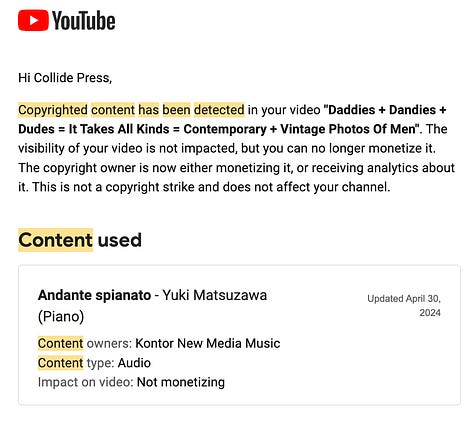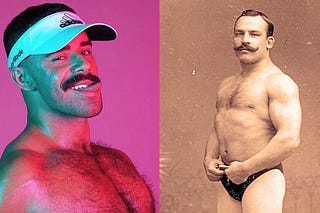
I was yesterday years old when I learned there’s a word for something I’ve been fighting for months: CopyFraud. It’s not a new concept (or term).
Way back in college, I took a Mass Media Law class (taught by a brilliant professor) and learned way too much about intellectual property law, including copyright law. That was over 30 years ago.
While Copyright Law hasn’t really changed in the past 30 years, the World Wide Web has changed everything. And what was once (mostly) clearly in the public domain is now…clearly used by corporations and other corrupt entities (see my personal “(s)hit list” below) to gatekeep and try to profit on works they have no rights to. None.
It’s infuriating, to say the least. The internet was supposed to democratize information and make knowledge more accessible to everyone. But instead, we’re seeing the opposite: a few powerful entities claiming ownership over things they have no legal right to, simply because they can, and because they think they can get away with it.
And many of them are using Google and YouTube’s systems designed to reduce copyright abuse against creators who are well within their legal rights. Like myself. And yet, Google and YouTube seem unable/unwilling to address the problem in any meaningful way. They love being Judge, Jury, Appeals Court, and Executioner when it goes AGAINST creators, but they can’t seem to be bothered to do anything that helps creators stop the rampant abuse…and fraud. (See my un-original solution below)
RELATED READING
WHAT IS COPY FRAUD? (Microsoft)
COPYFRAUD (Wikipedia)
COPYFRAUD (NYU Law Review)
DEAR GOOGLE: PUBLIC DOMAIN COMPOSITIONS EXIST
The term CopyFraud was coined by law professor Jason Mazzone back in 2006. He literally wrote a book on it. The practice is not only unethical but illegal in most cases. Yet, it happens all day every day—usually with few, if any, consequences for the perpetrators. And despite saying they address the abuses, tech companies mostly seem more than willing to let CopyFraud continue on unchecked.
These copyright con-men and grifters take advantage of the complexity and confusion surrounding copyright law, especially about what is/isn’t in the public domain.
They bet on the fact that most people don’t know enough about copyright law to challenge them. And, unfortunately, they’re usually right.
But that does not make it right. And so while I’m not an attorney, I fight. Each and every damn one of them. I report them. I make myself as much a pain in their ass as they have made themselves in mind. Because…principles matter.
Here’s how the game works: Many public domain works—whether old photographs, classical music recordings, or even ancient texts—are being slapped with dubious copyright claims by companies that had nothing to do with their creation. They might have merely digitized the content or slapped it onto a platform, and suddenly, they’re acting as if they own it. Some have no other connection to the work than they found it on the internet, so they think they’ve struck GOLD.
This isn’t just annoying; it’s a direct attack on the public domain, which is supposed to be a shared cultural resource for everyone. E-V-E-R-Y-O-N-E. Not just companies and individuals hoping to profit on the ignorance of others.
CLINT’S COPYFRAUD (S)HIT LIST
Here’s a short list of some of the worst CopyFraud fraudsters and grifters:
STOCK AGENCIES
These companies have been caught repeatedly claiming copyright on images that are clearly in the public domain. They’ll sell these images as if they own the rights, and if you try to use them without paying, you might get hit with a takedown notice or even a lawsuit.
COPYFRAUDSTERS (IMO) = ALAMY + BRIDGEMAN ART LIBRARY + GETTYMUSIC PUBLISHERS + SERVICES
Some of legitimate (and illegitimate music publishers) have been known to assert copyright over classical music compositions that are long past the copyright expiration date. They can/do often have rights recordings of those works, but claiming ownership of the compositions is a ridiculous and blatant attempt to profit from work that should be free for all to enjoy.
COPYFRAUDSTERS (IMO) = UNIVERSAL MUSIC GROUP + NAXOS DIGITAL SERVICES + SONY MUSIC + THE ORCHARD MUSIC + HEXACORP + LATINAUTOR + WARNER CHAPPELL + AND ON AND ON AND ONONLINE MARKETPLACES + SHOPS
Websites that allow users to sell vintage art prints or posters have been accused of removing listings and banning sellers who use public domain images—claiming that the images are copyrighted when they are not.
COPYFRAUDSTERS (IMO) = EBAY + ETSY + SPRINGMUSEUMS + CULTURAL INSTITUTIONS
Sadly, some private and public institutions which should be the stewards of our shared heritage, are engaging in CopyFraud. They claim copyright over digitized versions of artworks that are centuries old, restricting access to works that should belong to the public. This gatekeeping not only stifles creativity but also undermines the very purpose of these institutions. On the bright side, more and more institutions are making more and more of their works available for free.
COPYFRAUDSTERS (IMO) = MUSEUM OF FINE ARTS, BOSTON + TATE
YOUTUBE + CONTENT ID + COPYFRAUD = ABUSE
While I have experienced several problems since becoming part of the YouTube Partner Program, the two biggest problems revolve around YouTube’s Content ID system and Copyright Claim process.
This dynamic duo is a nightmare that small creators like myself know all too well.
NOTE: While I’m part of the YouTube Partner Program, I don’t consider myself a YouTube a “partner.” Because YouTube doesn’t treat me as one. They treat me and most creators like children and criminals. I’m in a program. They pay me as little as AdSense as possible…and pay me even less respect. I now return the favor.
Try using music in the public domain (or even covered under a Creative Commons license) and you’ll find yourself dealing with the least supportive support team on the internet: YouTube Creator Support. Not only will anything likely not get fixed…their team of bots and bot-like humans will do as much to frustrate you in the process.
File a dispute and wait up to 30 days for a response or for the claim to be dropped. (Sometimes to return again, btw.) The result is a lot of friction and frustration and a delay in getting any compensation for your work.
Makes AdSense to me. Not even two cents…or two AdSense.









YouTube’s Content ID system is supposed to help protect intellectual property. But in reality, it’s become a weapon for shady operators to exploit creators. In my repeated experience and opinion.
Companies like HAAWK (by third party) and Naxos Digital Services—which seem to have “copyfraud” as their main business model—are notorious for abusing Content ID and the copyright claim process.
These are just two of growing list of “music publishers” big and small that knowingly and willfully add public domain works to Content ID, in clear violation of YouTube’s policies. Their goal? “Sharing” ad revenue that rightfully belongs to content creators.
YOUTUBE + CONTENT ID + COPYFRAUD = A SOLUTION?
If YouTube’s bots and bot-like humans would use basic common sense (and follow another the lead of another team within their comapny—Google Arts & Culture), they could seemingly easily fix this problem by requiring Content ID submitters to include additional information (like when was is COMPOSED) and/or create a “cleared” list of compositions that are clearly in the public domain.
Classical music seems to be the easiest place to start. Anything by any of these composers, for instance, would not be allowed in Content ID. And if they did sneak in, any copyright claims would automatically be rejected:
JOHANN SEBASTIAN BACH (1685–1750)
WOLFGANG AMADEUS MOZART (1756–1791)
LUDWIG VAN BEETHOVEN (1770–1827)
FRANZ SCHUBERT (1797–1828)
FRÉDÉRIC CHOPIN (1810–1849)
ROBERT SCHUMANN (1810–1856)
FELIX MENDELSSOHN (1809–1847)
HECTOR BERLIOZ (1803–1869)
FRANZ LISZT (1811–1886)
RICHARD WAGNER (1813–1883)
GIUSEPPE VERDI (1813–1901)
JOHANNES BRAHMS (1833–1897)
PYOTR ILYICH TCHAIKOVSKY (1840–1893)
EDVARD GRIEG (1843–1907)
ANTONÍN DVOŘÁK (1841–1904)
GABRIEL FAURÉ (1845–1924)
CLAUDE DEBUSSY (1862–1918)
GUSTAV MAHLER (1860–1911)
From there, they could add popular composers and recordings. Same for silent films. Anything is better than what they seem to be doing now. Which is nothing.
They CAN make this system better. But first they need to admit it’s not GREAT.
SINKING THE TITANIC (OF COPYRIGHT)
These abuses are just the tip of the iceberg. The problem is widespread and only getting worse. The sad reality is that many of these companies get away with it because most people either don’t know their rights or don’t have the resources to fight back.
Our current copyright system is broken, I believe, beyond repair. It’s a mess of if/then statements written over too many years with more exceptions than rules. And more room for “interpretation” than even our current tax code. Creators need something that takes into account how work is actually created and distributed now.
Legacy media companies (and their enablers at tech companies) understand their old cons, frauds, and grifts aren’t working like they used to, so they keep devising new ones. Whether they’re legal or not, they are determined to win this fight. So am I.
FINAL THOUGHTS (ABOUT DAMN TIME, HUH?)
While I now subscribe to a music library—I pay a premium to avoid most of this grift—I do sometimes still use public domain classical recordings. And they almost always get at least one copyright claim.
On a recent video, I received TEN separate copyright claims on a video that used only FOUR recordings. Everyone seems to like Bach…and think they own his compositions.
These false copyright claims have been the bane of my existence more than I’d like admit. Fighting them was, for a time, a part-time job.
It’s disheartening to see a platform like YouTube, which says it champions creators, not only enable these exploitative practices but also seem to protect the abusers. YouTube rolls over and basically plays dead (in the head) when “publishers” make unverified copyright claims…all the while they threaten creators with terminations for far less severe “crimes and misdemeanors.”
Google/YouTube’s double standards and hypocrisy are infuriating.
Works in the public domain are worth fighting for. They are a rich and vital part of our cultural heritage. Works in the public domain belong to us all.
Allowing greedy corporations, individuals, and institutions to steal it piece by piece under the guise of copyright protection is unacceptable.
So, what can we do? Awareness is the first step.
The more people know about CopyFraud, the less power these entities have.
If you ever find yourself on the receiving end of a dubious copyright claim, don’t be afraid to challenge it. Research the work’s copyright status, consult with a lawyer if you can, and don’t let these grifters bully you into submission.
The internet is still a powerful tool for democratizing information—let’s not let it become just another playground for corporate greed. Let’s fight back against CopyFraud and protect what rightfully belongs to all of us.
Now, tell me—have you encountered CopyFraud in your own work or creative endeavors? Let’s swap stories and tips in the comments below.
Thanks for reading!
Clint
MORE FROM COLLIDE PRESS
Bluesky + Ko-Fi + Linktree + Shop
+ Storefront + Threadless + YouTube
















